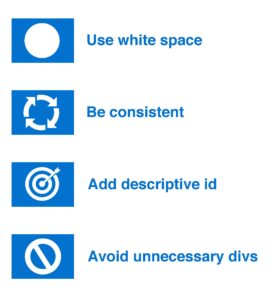© 2022 TouchStone Digital. All Rights Reserved. Privacy Policy. Careers.

Behind all good website content is solid HTML code. It’s the foundation of a website and is responsible for its appearance, function and overall performance.
Here are some rules of thumb to follow when you’re completing code housekeeping:
Use whitespace: Give yourself room to space out your code, so it’s easy to read. Indenting subsections is a key component of clean code and won’t affect page rendering. Indents help developers quickly identify which subsections belong to preceding elements. If all the lines were left-aligned, it would create a clunky block of code, so tab over once with every new element.
Be consistent: Maintain style guidelines throughout your code. For example, if you use dashes for classes or ids at the top of your page, don’t switch to underscores halfway through your writing. That makes it difficult for other web developers to decipher your work when adjustments need to be made.
Add descriptive id and class names: Those elements should be concise and accurate to avoid confusion. For example, using “bnr” could reference a page banner or banner background, so it’s best to spell out the complete description.
Avoid unnecessary divs: Divitis is a colloquialism that describes the overuse of divs in HTML and is a common problem in coding. Web developers often include a new div when wrapping an individual element for styling. A single web page may include dozens of styled elements, so the divs will add up. Review your HTML as you go to ensure you’re not overusing divs.
There are advantages to crafting a website with concise code, and boosting SEO value is one of the most important. While good content attracts human visitors, good code will draw search engine spiders to crawl your site.
Spiders don’t interact well with messy code, and you don’t want to make them hunt for valuable information. Keeping your code neat will help the crawlers get in and find the information they need, which will improve your ranking on search engine results pages (SERP).
Using software like iFrame or Adobe Flash is good for adding interactive elements, images and documents to a website, but they add unnecessary code that make crawling difficult. JavaScript and Cascading Style Sheets are alternative platforms that provide more concise coding options.
 Writing sloppy code makes it difficult to develop a site and gives a bad impression. Consider the potential problems messy code may cause for website maintenance.
Writing sloppy code makes it difficult to develop a site and gives a bad impression. Consider the potential problems messy code may cause for website maintenance.
Spotting and fixing bugs is easier when you’re working with clean code. Trying to pick your way through poorly written HTML can be time-consuming, which poses a problem if you need to address a site error quickly.
Creating quality code requires consideration and thinking ahead. But since you likely won’t be the only developer working on a site, it’s worth the effort. It’s important to be thorough, so other developers can easily read and interpret your work. That will help them update the site to accommodate ever-changing compliance standards.
The web developers at TouchStone Digital are well-versed in simplifying and cleaning up code to optimize your site’s performance. Call 419-299-9000 or contact us online to learn about our services.
Share article
© 2022 TouchStone Digital. All Rights Reserved. Privacy Policy. Careers.